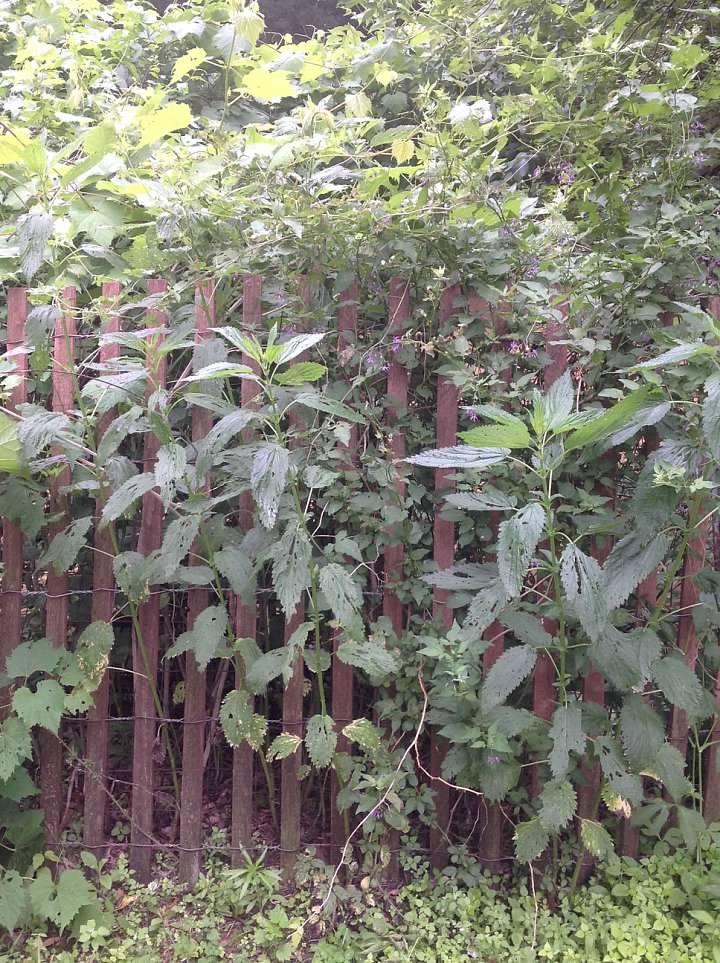Botany of Stinging Nettle, Urtica Diocia
I first met this awesome plant on a sunny day after the rains in Serbia. I was stomping through some mud when I found myself falling back. I reached for the closest thing around. Once I grabbed on, I couldn’t think of anything else except my burning hand. And that is how I discovered stinging nettle. Anyone that knows anything about stinging nettle knows that it burns/stings when it touches your skin and it can leave welts. I’ve heard the sting can last for a whole day, but my experience has never been that long.
PLANT FAMILY
Nettle is found all over the world. There are 500 species in the Nettle family, or Urticaceae family. Not all have the stinging hairs such as those found on Urtica diocia, which happens to be the variety I encountered in Serbia and that around my home.

A young batch of nettle.
APPEARANCE
This plant is not breath taking or eye catching at all. Unless you are familiar with the plant you would probably not even notice it. Most people get to know this plant the way I did, you first meet the sting.
LOCATION
This wild plant is found in part sun, part shady locations where the soil stays pretty moist and is very rich. Nettle loves soil that is loaded with nitrogen. It sucks it right up. I find it near roadsides, in my garden, near the river by my house, and other such areas where the soil has been worked. It can also be found in wastelands, grass fields and around places with animals. Word is, if nettle is around, then the soil is good and rich.

DESCRIPTION-STEM
In the Spring this baby will start to pop up with purple leaves. It grows on a long single stem anywhere from 3-7 feet tall. The stem is thick, square, fibrous and covered with stinging hairs called trichomes. The trichomes contain formic acid which cause the burning sensation should one rub up against it.

Stinging nettle’s first appearance in early Spring. 
DESCRIPTION-LEAVES
The slender heart shaped leaves are also covered in the stinging hairs. The leaves grow opposite each other up along the stem. At the base of each leaf, kaboom, more trichomes. The leaves are toothed and deeply veined giving the leaves a coarse and textured feeling. Just incase you were wondering… the leaves are green.
DESCRIPTION-FLOWERS, REPRODUCTION, SEEDS
By mid-summer the flowers start to appear. Stinging nettle is a dioecious plant meaning that it has both male and female flowers. But not always will both male and female be found on the same plant. From the axil where the leaves meet come the flowers which don’t have much of a scent. The teeny tiny yellow-green flowers grow in clusters. I think of grapes when I see their cluster of flowers or seeds. Male flowers grow upwards and the female downwards, I speculate this is for reproductive purposes. Neither of the flowers have petals, instead they have 4 sepals and 4 stamen and the female a single pistil. Reproduction happens when the male flower opens to release pollen that falls onto the female flower and caught by its pistil. This pistil turns into the seed, thereby making the female flowers sole producers of seeds. And it is by the seeds that nettle spreads. When young the seeds are light green and turn to brown as they mature.
DESCRIPTION -ROOTS
The stolon is another way that nettle spreads. Under the soil nettle has more of a rhizome structure than roots. There are two parts: the stolon which spreads outward and the more root like part that grows downwards. Nettle is a perennial so it will come back every year.

Stinging nettle skeleton. 
Nettle in winter 
There you have it… the botany of stinging nettle.
Learn how to harvest stinging nettle and respectful wildcrafting techniques.
Other Entries on Stinging Nettle

Sources:
- Berger, Judith. “Herbal Rituals”. St. Martin’s Griffin, New York. 1998. P 131
- De la Foret, Rosalee “Stinging Nettle Monograph”. Learning Herbs, Herb Mentor. Herbmentor.learningherbs.com/herb/stinging-nettle. Accessed February 21, 2019.
- De la Foret Rosalee “Learning Your Plants, Leftovers Part 1” Learning Herbs, Herb Mentor. Video Course: Learning Your Plants. January 18, 2012.
- De la Foret, Rosalee. “Nettle Shake”. Learning Herbs, Herb Mentor. Articles: Remedies & Recipes. http://www.herbmentor.learningherbs.com/articles/remedies-recipers/nettle-shake/#marker-8379-2
- Elpel, Thomas J., “Botany in a Day, The Patterns Methods of Plant Identification, An Herbal Field Guide to Plant Families of North America”, 6th Edition. Hopps Press, LLc., Pony, Montana. January 2018. Page 90.
- Houdret, Jessica and Farrow, Joanna. “The Kitchen & Garden Book of Herbs: Knowing, Growing, Cooking”. Hermes House, Anness Pulishing Ltd, London. 2006. P 226.
- McDonald, Jim, “Nettle”. Learning herbs, Herb Mentor. herbmentor.learningherbs.com/plantwalk/stinging-nettle-plant-walk November 12, 2012.
- Mother Earth News Staff. “The Many Stinging Nettle Benefits”. Mother Earth News. Mother earthnews.com/natural-health/stinging-nettle-benefits-zmaz81mazkin. March/April 1981.
- 7Song. “Nettle, Plant Walk”. Live from Root Stalk by Mountain Rose Herbs. February 4, 2013. Herbmentor.learningherbs.com/plantwalk/nettle-plant-walk.








Leave a comment